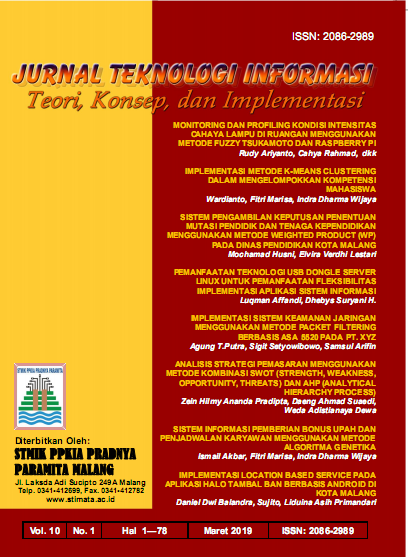IMPLEMENTASI METODE K-MEANS CLUSTERING DALAM MENGELOMPOKKAN KOMPETENSI MAHASISWA
Abstract
Academic ability is the ability of a person who is included in the academic field with a measure can be in the form of value or so-called academic achievement. With this system helps in grouping students in their fields, and students can find out the competencies obtained based on the achievement index of the courses that have been determined. In making this system, researchers used Visual Studio 2012 and applied the K-Means Clustering algorithm method to get more accurate results in classifying student competencies. This system can be used for all departments, the testing is done at the Informatics Engineering Department of Malang Widyagama University. in this system uses the mysql database for storage. Based on the user test results that have been done, Based on the results of the user trials that have been conducted, of the 5 weighted values that have been determined, there is an average of the results of the trial which is 85.6% strongly agree with the existence of this system to find out the student competency group.It is expected that with this system. Can find out competency groups that are suitable for their fields, so that later they will produce graduates who are competent in accordance with their fields
.
Keywords : Competence, K-means Clustering, software visual
References
Adrianto, R., & Fahmi, A. (t.thn.). Penerapan Metode Clustering Dengan Agoritma K-Means Untuk Rekomendasi Pemilihan Jalur Peminatan Sesuai Ke Mampuan Pada Program Studi Teknik Informatika-S1 Universitas Dian Nuswantoro. Universitas Dian Nuswantoro.
Aranda, J., & Natasya, W. A. (2016, Februari). Penerapan Metode K-Means Cluster Analysis Pada Sistem Pendukung Keputusan Pemilihan Konsentrasi Untuk Mahasiswa International Class STMIK AMIKOM Yogyakarta. Seminar Nasional Teknologi Informasi Dan Multimedia.
Atmajaya, D. (2016, Februari). K-Means Algorithm. Diambil kembali dari http://lecturer.fikom.umi.ac.id/dedyatmajaya/k-means-algorithm/
Choizes, E. (2018, april 22). diedit. Diambil kembali dari Kuesionernya, Pengertian Skala Likert dan Contoh Cara Hitung: https://www.diedit.com/skala-likert/
Febriani, L. (2012). Pengelompokan Mahasiswa Sistem Informasi Berdasarkan Tingkat Kompetensi Akademik Dengan Fuzzy K-means. Jurnal EKSIS, 05, 19-29.
Hadi, R., Putra, I., & Kumara, I. (2016, Juli). Penentuan Kompetensi Mahasiswa Dengan Algoritma genetik Dan Metode Fuzzy C-Means. Jurnal Elektro.
MacQueen, J. (1967). Some Methods For Classification and Analysis of Multivariate Observations. proceedings of 5-th berkeley Symposium on Mathematical Statistics and Probability, (hal. 281-297). University of California Press.
Mangkunegara, A. (2005). Manajemen Sumberdaya Manusia Perusahaan. Bandung: PT Remaja Rosdakarya.
Poerwanto, B., & Fa'rifah, R. Y. (2016, Oktober). Analisis Cluster K-means Dalam Pengelompokkan kemampuan Mahasiswa. Jurnal Scientific Pinisi, 92-96.
Raharjo, B. (2016). Mudah Belajar Visual Basic.NET. Bandung: Informatika.
Riadi, M. (2017, september). Pengertian, Fungsi, Proses dan Tahapan Data Mining. Diambil kembali dari Kajian Pustaka: https://www.kajianpustaka.com/2017/09/data-mining.html
Sustrisno, E. I. (2011). Manajemen Sumber Daya Manusia. Jakarta: Kencana.
Wahana. (2013). Memebangun Aplikasi Database Dengan Visual basic 2012. Yogyakarta: Andi Offset.




